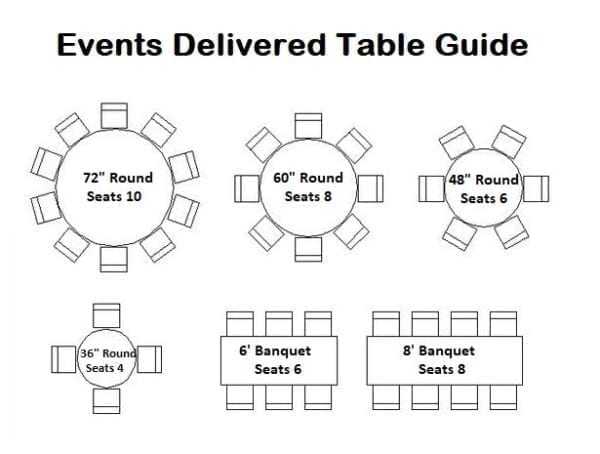When it comes to hosting gatherings whether they are intimate celebrations, lively family reunions, or formal business meetings, one essential consideration looms large: seating. A well-thought-out seating arrangement not only enhances the overall ambiance, but it also fosters engagement among guests. Enter the 52-inch round table, a versatile yet often underappreciated hero in the universe of event seating solutions. How many guests can it comfortably accommodate? Let’s delve into this fascinating inquiry.
First, envision the 52-inch round table—a delightful centerpiece that can transform any space into a welcoming area for connection and conversation. The round design inherently promotes inclusivity, allowing everyone to see and interact with each other effortlessly. As we explore seating capacity, it’s pivotal to consider comfort and practicality in varying contexts.
To ascertain how many guests can be seated at such a table, we must first consider the dimensions. A 52-inch diameter translates to a circumference of approximately 163 inches. Generally, event planners and caterers advocate for around 24 inches of personal space per guest. This guideline serves as a helpful benchmark that balances intimacy and comfort without compromising the experience for anyone seated.
With this framework in mind, we can derive the optimal seating capacity. If we divide 163 inches by 24 inches, we find that the round table can comfortably accommodate approximately seven guests. However, this figure rests on the assumption that guests will be seated without additional items like centerpieces or place settings taking up crucial space.
Now, let’s factor in the dynamics of social gatherings. The nature of the event is incredibly influential in the seating arrangement. For instance, a casual birthday party might fill every available spot, accommodating eight guests around the table, while a more formal dinner party may prefer a capacity of six, allowing diners to enjoy a less congested experience. Flexibility is integral here; knowing your audience and adjusting accordingly could transform a good gathering into an exceptional one.
Moreover, consider the variations in chair design. Traditional banquet chairs are typically narrower than plush upholstered ones, which means they can allow for an increased seating capacity without compromising comfort. Hence, the choice of furniture significantly influences your arrangements. Using armless chairs can also free up precious space, making room for more guests while still ensuring they feel at ease throughout the event.
The event’s specifics extend beyond merely counting physical chairs. For events centered around dining, the layout becomes particularly crucial. Do your guests require sufficient elbow room to enjoy their meal without feeling cramped? The answer is a resounding yes. Ample space between diners not only facilitates relaxation; it also enhances the dining experience overall. As you strategize your seating, remember that guests’ enjoyment is paramount, and the capacity should not overshadow their comfort.
In addition to physical comfort, social dynamics play a pivotal role in how many individuals can be seated at a 52-inch round table. Think about the diversity in guest familiarity. A table filled with close friends will engender a lively atmosphere, whereas a corporate meeting may necessitate a more restrained approach to seating. Mixing or seating guests of similar backgrounds together can help stimulate conversation, creating an environment that feels inclusive and engaging.
There’s also the matter of accessibility. In environments with guests requiring special accommodations, it’s essential to ensure that the seating arrangement is both accessible and respectful. An open area surrounding the table can facilitate movement and ensure that everyone feels welcome.
What about decorative elements? Including centerpieces, tableware, or decorations can also impact seating capacity. While they add flair, overly elaborate centerpieces can infringe on the space available for diners. To strike a balance, consider low-profile arrangements that bring beauty without hindering conversation or elbow room. Keep in mind that the table should remain a social hub, an epicenter of engagement, and not solely a decorative display.
In addition to these considerations, the event’s duration can influence how many guests a round table can accommodate. For longer gatherings, comfort must be prioritized. Guests may prefer more space and an arrangement that reduces squished conversations, especially during extended dining experiences. Conversely, for a cocktail hour or informal gathering, an intimate atmosphere can be fostered without compromising too much on space.
Ultimately, seating at a 52-inch round table embodies a delicate balance of numbers and nuance. Whether you choose to seat six, seven, or eight guests is influenced by a plethora of factors, including the nature of the event, decor considerations, and each individual’s comfort. This table size offers flexibility; when armed with an understanding of its dimensions, the options become limitless.
So, the next time you plan a gathering, remember the humble yet powerful 52-inch round table. It beckons us to rethink traditional seating arrangements, encouraging mingling, conversation, and connection. With careful consideration and a dash of creativity, your seating solutions can not only meet expectations but exceed them, transforming an ordinary event into an extraordinary experience.
